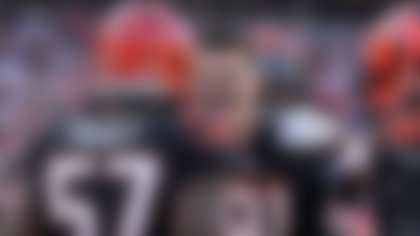Short passes might keep the chains moving, but it's the deep ball that dominates the highlight reel.
As I did a year ago, I'm examining deep throws (pass attempts of 20-plus air yards) from the previous season to determine the league's best based on Next Gen Stats' data. To qualify for this list, a player had to have at least 30 deep pass attempts in 2020, and to filter out the best from the rest, a passer rating of 100.0 or better on deep attempts was required.
As you'd expect, I was left with a strong group of qualified passers, but there are some notable omissions from the top 10. The first one that leaps off the screen (and will likely attract an avalanche of angry tweets) is the absence of perhaps the league's top quarterback and most exciting deep passer: Patrick Mahomes´╗┐.
Allow me to explain. We relied on a group of metrics to rank the qualifying passers. Chief among them: completion percentage over expectation (CPOE), which represents the difference between a passer's expected completion percentage (determined by evaluating a number of factors, including pressure, time to throw, distance of attempt and separation between targeted receiver and nearest defender) and actual completion percentage. A positive CPOE indicates performance above expectation, while a negative difference indicates performance below expectation. Mahomes ranked last in CPOE among the QBs who met the aforementioned statistical requirements, with a mark of -0.7 percent.
The talent around Mahomes could be working against him when it comes to CPOE. A key part of determining expected completion percentage is the separation of a receiver from the nearest defender at the time a pass arrives. A quarterback equipped with receivers who are excellent at creating separation figures to suffer in this regard because he'll have more expected completions than your average QB. With targets like Tyreek Hill´╗┐, Mecole Hardman and Travis Kelce´╗┐, Mahomes' situation becomes the perfect storm to produce a negative CPOE, even though we all know he is an excellent passer. As they say, speed kills, but it also can significantly hurt a quarterback's CPOE.
This is primarily why Mahomes -- who posted a 107 passer rating and 12:2 TD-to-INT ratio on deep passes -- didn't land on this list. It's essentially a requirement to end up with a positive CPOE to make the cut. If a quarterback isn't at least meeting expectation on deep throws, I'm not going to include him in the top 10.
And finally, coming in on the low end of downfield attempts can hurt a quarterback's chances of earning a spot here, as well. Ryan Tannehill posted a 100.9 passer rating, a 5:2 TD-to-INT ratio and a CPOE of +4.2 percent on deep throws, but gained just 514 yards (last among qualifiers) via those attempts. He ended up just outside the top 10 along with Matthew Stafford and Mahomes.
All right, enough with the explaining about why certain players didn't make the list. Let's get to the top 10.
´╗┐´╗┐Deep attempts: 26-of-64, 771 yards, 9:3 TD-to-INT ratio, 106.2 passer rating
Comp: 40.6%
xComp: 33.5%
CPOE: +7.1%
All right Bills fans, put away your torches and pitchforks. Your newfound king has finally received his recognition on this list. As we all recall, Allen was a dynamite passer in 2020 and one with a penchant for making the big play. The arrival of Stefon Diggs from Minnesota helped Allen finish with the second-most deep completions to wide open receivers (10) in 2020. That number deflated his CPOE but didn't tank it, as evidenced by his finish in the top 10 at +7.1 percent.
Like others on this list, Allen's improvement in 2020 was clearly visible in his deep passing numbers, as he leapt from -10.1 CPOE in 2019 to +7.1 in 2020, an increase of 17.2 percentage points, the second-largest jump in the league behind Daniel Jones (19.7). Allen's ability to make plays with his legs shined through these numbers as well, as he led the league in deep completions while on the run with eight. Allen showed in 2020 that he's the franchise quarterback Buffalo hoped he'd be when it selected him in the first round of the 2018 draft. These numbers only reinforce that reality.
Deep attempts: 23-of-61, 885 yards, 11:3 TD-to-INT ratio, 104.7 passer rating
Comp: 37.7%
xComp: 28.6%
CPOE: +9.1%
Herbert blew the doors off the league in Year One, winning the Offensive Rookie of the Year award and tying Baker Mayfield's rookie record for deep touchdown passes with 11. The first-round pick out of Oregon more than held his own when the pass rush was closing in on him, too. Herbert racked up 415 passing yards and five touchdowns on deep passes when under pressure, both most in the NFL. He didn't need the comfort of the Ducks' shotgun-only offense to do so, either, throwing five touchdowns on deep passes from under center (tied with Kirk Cousins for the league lead).
Despite being a rookie who was often under pressure, Herbert delivered with a CPOE of +9.1. There's occasionally a beautiful moment when a pro quarterback fires a rope through a crowded secondary for an unlikely completion. It's even more breathtaking when it comes from a rookie who was thrown into the fire unexpectedly in Week 2. Herbert is just getting started.
Deep attempts: 26-of-67, 948 yards, 13:4 TD-to-INT ratio, 101.2 passer rating
Comp: 38.8%
xComp: 30.6%
CPOE: +8.2%
No one was more productive on the scoring front when going deep than Wilson, as he led the league in deep passing touchdowns with 13. Four of those came on the run, which was an NFL-best in such scenarios. Wilson initially landed ninth on this list, but we've bumped him up a place to give him the credit he deserves for his continued excellence. He has been the top downfield passer in the NFL since the advent of the Next Gen Stats era in 2016, leading the league in passing yards (5,369), passing touchdowns (56), completions (156) and attempts (378) in that span. He's also one of just two quarterbacks (joining Matthew Stafford) with a CPOE of +3 or better in each of the last four seasons. While he wasn't the best when going deep in 2020, he's been the top dog since we started tracking these advanced metrics a few years ago.
Deep attempts: 24-of-56, 730 yards, 8:2 TD-to-INT ratio, 114.6 passer rating
Comp: 42.9%
xComp: 33.7%
CPOE: +9.1%
Say what you will about Kirk Cousins, but he finds his way into this space year after year. In fact, Cousins hasn't budged a single position on this list from last year, and he posted a better CPOE in 2020 at +9.1 percent (up from +6.4 in 2019). His passer rating was slightly lower, dropping from 121.5 to 114.6, and his TD-to-INT ratio went from 9:1 in 2019 to 8:2 in 2020. The statistics illustrate a quarterback who is about as steady as they come when looking downfield, even after his offense changed coordinators with the departure of Kevin Stefanski last offseason.
What's most remarkable is Cousins' ability to remain steady when faced with a major increase in high-difficulty throws. After targeting receivers in tight windows on roughly one-fifth of his deep attempts in 2019, Cousins threw to pass catchers in tight windows on 44.6 percent of his deep attempts in 2020, the highest rate of any passer on this list. And yet, his numbers still remained startlingly similar. Cousins led the NFL in deep passing yards from snaps taken under center last season with 500 and tied for the lead in deep passing touchdowns out of play-action with five even though his receivers averaged just 1.6 yards of separation on deep targets, the fifth-fewest in the entire league.
Deep attempts: 23-of-47, 714 yards, 5:2 TD-to-INT ratio, 112.7 passer rating
Comp: 48.9%
xComp: 37.7%
CPOE: +11.2%
Mayfield made it to this list at No. 10 after a dreadful 2019 season for the Browns, so it's no surprise he's ranked higher after Cleveland turned things around in a big way in 2020. Mayfield wasn't quite one to light up the scoreboard on deep passes, but he was incredibly effective out of play-action. Thanks to the threatening presence of running backs Nick Chubb and Kareem Hunt, Mayfield racked up 426 deep passing yards on play-action passes, tying for second-most in the league. His 12 deep completions off play-action were the third-most in the league, driving home what we all observed in 2020: The Browns are at their best when they use a run-first foundation and catch the defense napping when going to the air. Mayfield went from a CPOE of +3.9 percent and passer rating of 72.9 on deep passes in 2019 to a +11.2 CPOE and 112.7 rating in 2020. His arrow is very much pointing upward, and the Browns appear poised to continue the trend in 2021 with the expected return of a healthy Odell Beckham Jr.
Deep attempts: 26-of-54, 931 yards, 9:3 TD-to-INT ratio, 110.7 passer rating
Comp: 48.1%
xComp: 35.2%
CPOE: +12.9%
Watson owns a higher CPOE than Aaron Rodgers and Kyler Murray, but he ends up ranked directly behind them because he had a lower mark in passer rating. Watson's herculean efforts in 2020 helped elevate some of his top targets in his first NFL season without DeAndre Hopkins. The fact that he made this list despite losing Hopkins in the offseason is an accomplishment in itself. Consider this: Watson is one of four quarterbacks to post a CPOE of +6 percent or better on deep passes in each of the last two seasons, and he did so in 2020 without the All-Pro, Hopkins, as part of a team that was forced to try to throw its way to victory for much of the season. Watson was often tasked with trying to throw the Texans back into games, meaning he had to air it out in the fourth quarter. He was phenomenal in that regard, posting a CPOE of +20.8 on deep passes in the fourth quarter or overtime in 2020, the highest mark in the entire league (min. six attempts).
Deep attempts: 31-of-74, 1,219 yards, 12:0 TD-to-INT ratio, 128.7 passer rating
Comp: 41.9%
xComp: 33.8%
CPOE: +8.1%
Rodgers has a strong case for landing among the top three on this list, given that he led the league in deep passing yards with 1,219, but he lands just outside of it because of how he arrived at that total. Rodgers had the second-most deep pass attempts of any qualifying quarterback in the NFL in 2020 with 74, which explains why his CPOE is lower than that of most players on this list (the higher total of passes increases the chances he'll exceed expectation at a lower rate due to sheer volume). Rodgers also had the highest total expected points added -- a metric used to define how well an individual player is contributing to his team's success -- on deep passes in 2020 at 74.3, punctuating a premier performance from the veteran. It helped that he had Davante Adams -- one of the top 10 pass catchers from last season -- who made much of his deep-ball hay from the slot in 2020. Rodgers led the NFL with 14 completions, 557 yards and six touchdowns on deep passes to slot receivers in 2020. In all, we were reminded of what we already knew: Rodgers is a fantastic passer downfield, and the Packers aren't afraid to use his talents to their advantage.
Deep attempts: 23-of-58, 874 yards, 8:0 TD-to-INT ratio, 126.8 passer rating
Comp: 39.7%
xComp: 28.4%
CPOE: +11.2%
The former first overall pick was excellent in 2020 when it came to targeting receivers downfield and continued what he started in 2019, finishing 2020 as one of only four quarterbacks with a CPOE of +6 percent or better in each of the last two seasons (the others: Deshaun Watson, Kirk Cousins and Russell Wilson). He was especially effective throwing downfield off play-action, posting a passer rating of 154.9 and 436 passing yards on deep targets out of run fakes in 2020, the highest marks in the NFL. The threat of the run will always give opposing defenders pause when reacting to whatever coach Kliff Kingsbury has drawn up for Arizona, but Murray is far from just a runner. His stellar marks proved he's plenty dangerous when letting it rip downfield.
Deep attempts: 24-of-52, 968 yards, 10:1 TD-to-INT ratio, 124.2 passer rating
Comp: 46.2%
xComp: 31.7%
CPOE: +14.5%
GM Mike Mayock was not shy about expressing the confidence he has in Carr this offseason. And after looking at the QB's deep passing numbers, it's easy to understand why the team decided to maintain the status quo at the position. Carr posted an impressive CPOE of +14.5 percent and passer rating of 124.2 on deep throws last season. His TD-INT ratio of 10:1 explains his stellar rating, but what's even more encouraging about Carr's performance was how well he played when under duress. Carr led the NFL with 11 completions, 426 passing yards and six touchdowns on deep passes against the blitz in 2020. He also posted the second-highest expected points added on deep passes at 60.2. Carr took a massive year-to-year leap when going deep, posting a CPOE improvement of +15.1 percentage points on downfield attempts, lifting himself out of the negative and well into positive territory. He did this all despite a relatively quiet debut season from deep threat Henry Ruggs III, who needs to improve at getting in and out of his breaks as he enters Year Two, per Mayock. Carr might wish he still had free-agent departure Nelson Agholor, though, as the wideout accounted for six deep passing touchdowns in 2020, the second-most in the NFL behind Tyreek Hill's eight. Regardless, Carr had a strong response for anyone questioning his ability to throw the deep ball in 2020.
Deep attempts: 19-of-39, 636 yards, 5:0 TD-to-INT ratio, 134.3 passer rating
Comp: 48.7%
xComp: 33.9%
CPOE: +14.8%
Giants fans looking for proof that Jones can become the franchise QB he was drafted to be are getting a generous helping with this choice. Sure, it's a surprise to everyone to see him No. 1, but the numbers don't lie. Jones went deep just 39 times but was very effective when doing so, and his year-to-year improvement is incredibly encouraging. After posting a CPOE of -4.9 percent in 2019, Jones took a massive leap in 2020 to +14.8 percent, an improvement of +19.7 percentage points, the largest in the entire league from 2019 to 2020. It seems head coach Joe Judge's arrival did more than just turn the Giants into a scrappy bunch -- it also elevated Jones' effectiveness downfield. His passer rating on deep throws was the highest in the league at 134.3, and his completion percentage on such attempts (48.7) was the fourth-highest mark. Jones still has to prove he has what it takes to help the team be a consistent winner, but if he remains on this trajectory, we might not be spending much more of our future days debating his viability.
Follow on Twitter.






















